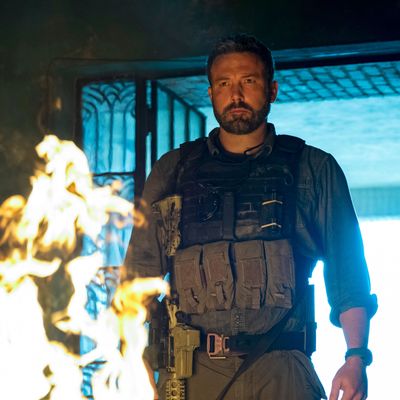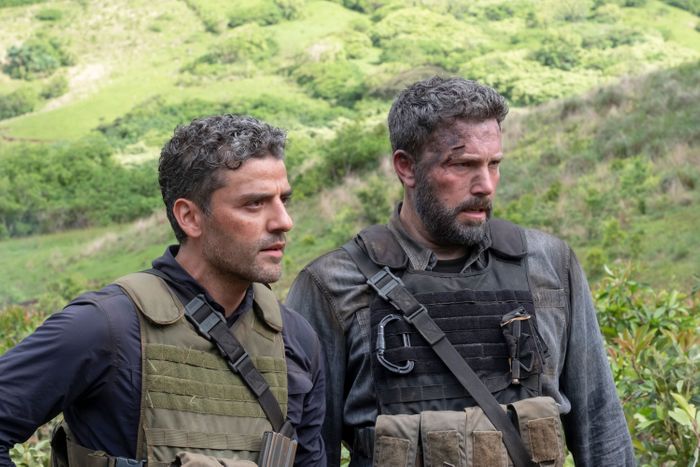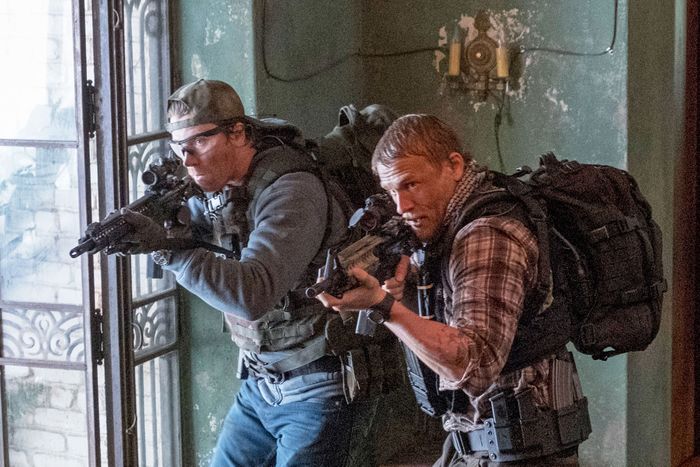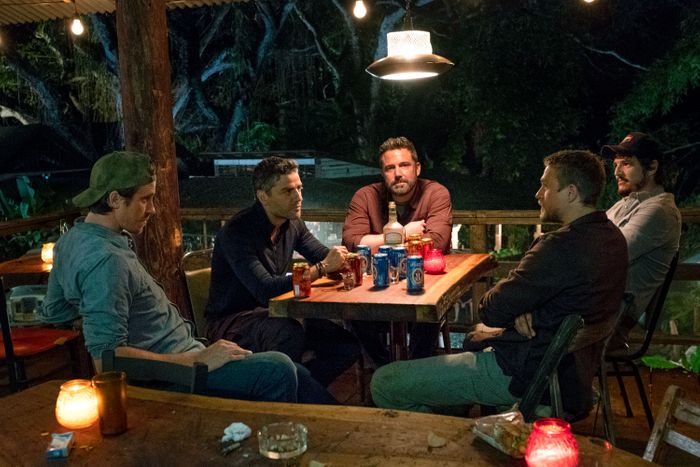
To hear it from the producers of Triple Frontier — who shepherded the movie through untold obstacles and ego clashes as the project imploded and resurrected no fewer than three times over the course of a decade — the Ben Affleck–starring action-drama both is and isn’t the film they expected to reach the screen. Even the type of screen the film (colloquially known as The Movie That Refused to Die™) currently plays on has defied expectations.
The movie’s journey to Netflix, where it appeared suddenly on a Wednesday, is the stuff of studio-chaos lore. It began life as an imposing Paramount production, with a script by Oscar-winning screenwriter Mark Boal. Director Kathryn Bigelow — Boal’s collaborator on the Best Picture winner The Hurt Locker and Best Picture nominee Zero Dark Thirty, who is also the first woman to win a Best Director Academy Award — was chosen to command a cast that cycled through a roundelay of moviedom’s biggest A-list actors. Will Smith, Johnny Depp, Mark Wahlberg, Mahershala Ali, and even a newly swole Tom Hanks were all variously reported as “circling” and “in talks” for lead roles over the years. Affleck was attached, and then he wasn’t; he temporarily dropped out to complete a rehabilitation-clinic stay for alcohol addiction. In the midst of everything, Bigelow stepped away, too, only her departure was permanent. Studio backing followed. The movie eventually went into “turnaround,” all its fumblings relegated to a loss on Paramount’s tax return. Like so many worthy scripts before it, Triple Frontier seemed destined for the graveyard.
But then, in its darkest hour in 2017, the project was rescued from movie oblivion, by none other than the streaming giant Netflix. It struck a distribution deal with Paramount, giving Triple Frontier a token run in 20 North American theaters earlier this month before adding the propulsive-yet-lugubrious thriller to its streaming service on March 13.
“We were occasionally amazed by the challenges thrown in front of us along the way,” Triple Frontier producer Alex Gartner tells Vulture, “but we never lost faith.”
Triple Frontier centers on a team of elite ex-special-forces soldiers who travel somewhere near the crime-ridden jungle junction between Paraguay, Argentina, and Brazil (“la triple frontera” of title fame, although the exact location is never quite indicated in the film) to pull off a dangerous heist: robbing a powerful Pablo Escobar–esque drug lord. They’re the good guys, America’s best, but have variously succumbed to the doldrums of post-military life when they endeavor to deploy their commando skills toward a monumental cash grab. Needless to say, nothing goes as planned.
Although things started out auspiciously enough, the best-laid plans for Triple Frontier proved similarly plagued. It all began in 2008, when Bigelow and Boal, still in postproduction on the bomb-disposal drama The Hurt Locker, approached veteran producer Charles Roven (12 Monkeys, American Hustle, the Dark Knight trilogy) about helping them set up a new studio production deal. Boal delivered his first draft of a script just weeks after winning his Best Original Screenplay Academy Award in 2009, compelling Paramount to green-light the new movie with a $60 million production budget (a fairly modest sum considering its locations and numerous shoot-‘em-up action set pieces). Soon, Hollywood’s most bankable leading men began negotiating star turns. Sean Penn, Javier Bardem, and Christian Bale all reportedly circled the project. Roven publicly mused a 2011 start date to accommodate Johnny Depp’s packed schedule. Tom Hanks was even reported to have accepted the role that ultimately went to Affleck, allegedly undergoing rigorous workouts and packing on muscle to more convincingly portray a black-ops badass.
“I can’t swear his deal was made — maybe it was in the process — but he was in training,” Roven says of Hanks. Adds Gartner, “I remember he was in excellent shape.”
However, Tom Hanks’s publicist Leslee Dart begs to differ. “It’s not even close to being true,” Dart tells Vulture. “There was no deal, no start date. He may have been in excellent shape. But it had nothing to do with prepping for the film.”
If rumors of gym-bound Hanks weren’t enough, enter industry chatter around Will Smith, who reportedly joined the running for a starring Triple Frontier part circa 2010. According to a widely cited Hollywood Reporter article, an uninterested Bigelow refused to meet with Smith, only capitulating when her Creative Artists Agency reps begged Paramount to press the director into conversation. Roven waves this off as fake news. “No, that’s not accurate,” he says. “He did have an interest in it, and she had an interest in meeting with him, and they had a couple of meetings.” (A representative for Bigelow did not respond to Vulture’s request for comment; through a spokesperson, Boal declined to be interviewed.)
As Triple Frontier’s potential cast grew more and more expensive, so did the movie’s overall budget — which by 2014 had reportedly reached $80 million. Around that time, two years after the release of their acclaimed Hurt Locker follow-up, the terrorism potboiler Zero Dark Thirty, Boal and Bigelow abruptly departed Triple Frontier.
“It was a very sought-after property,” Roven contends. “Mark wrote a really terrific script and had a lot of really terrifically talented people chasing it. But ultimately, it didn’t work out and Kathryn focused their attention on a different project. At that point, having done two military movies — I’m just surmising — Kathryn wasn’t interested in directing a third,” he adds, before making clear that he gave Bigelow “every opportunity to decide if she ever wanted to come back in.” (Both Bigelow and Boal are listed as executive producers on Triple Frontier, but neither had any creative input on the project since quitting the film.)
According to an insider privy to studio meetings and internal communications between the filmmakers and producers, Bigelow’s decision to walk came down to a clash of personalities. “None of those guys got along,” says the source close to the movie. “Kathryn couldn’t stand Roven and the deal ended. After Kathryn pulled out, Mark didn’t want to work with Roven and Roven didn’t want to work with Mark. So Mark just pulled out of it.”
Roven and Gartner deny that “creative differences” — Hollywood’s go-to code speak for an inability to get along inside the filmmaking sandbox — resulted in Bigelow’s departure. “I don’t want to say that I ever had an in-depth conversation with her about what her reasons were for not reengaging,” says Roven. “I think that it was just transmitted to us that she just wasn’t going to do the movie.”
“There was a sea change in worlds for them [from] when this project was set up,” Gartner says. “Hurt Locker won Best Picture. And I really think it was just that they were looking at what they wanted to do from a very different place from when they started. It wasn’t about creative differences. I think we all wanted to make the same movie.”
Even without an Oscar-winning director attached, Triple Frontier maintained its buzzy momentum. In 2017, J.C. Chandor, a Sundance-sanctified writer-director behind the 2011 financial-crisis drama Margin Call and the well-reviewed crime drama A Most Violent Year, was hired to direct the movie; an unexpected choice given Chandor’s absence of action-movie bona fides and reputation for only directing his original scripts. A hired gun, he most decidedly was not. “Once [the film] came back to life again, J.C. really intrigued us,” Gartner says. “It wasn’t about action cred. It was more about him being an actor’s director and the performances he had gotten on his other three movies, which were really interesting.”
“We wanted to make a classy, dramatic action film,” says fellow Triple Frontier producer Andy Horwitz. “When he expressed interest, it was exciting to us because he ticked those boxes.”
Around that time, Chandor took another meeting with Depp, who remained interested but couldn’t commit, and began extensively rewriting Boal’s script. Enter Channing Tatum and Tom Hardy, who started talks to occupy co-lead roles in the long-gestating thriller. To hear it from our source, however, the two actors lacked, to put it gently, personal chemistry. “Tatum and Hardy, that was real, and they ended up hating each other,” says the insider.
I ask Roven if this is true. “The true, real issue was creative differences,” the producer says. Insists Gartner, “As they came onboard, a creative process started and it didn’t gel.”
Then in February 2017, ahead of his first Academy Award win, Mahershala Ali joined the list of actors “in negotiations” to co-star in the embattled project. It would have been extraordinary timing for Triple Frontier, had Ali’s reported involvement not been followed by the announcement in April that, just four weeks from the film’s intended production start date, Hardy and Tatum were dropping out. According to published reports, lingering unhappiness with the direction of Chandor’s retooled script had caused them to flee.
That’s when Paramount, at the end of its rope after eight years in preproduction, sinking untold money into location scouting and pre-preparation, dropped the movie altogether. The decision forced Triple Frontier into “turnaround”: Hollywood parlance for when a studio declares a tax loss on a project it has spent substantial money developing, thereby murdering any further development prospects.
Like Tim Burton’s Superman Lives and Stanley Kubrick’s Napoleon, Triple Frontier appeared to be fated for the filing cabinet. But around the same time, a serendipitous reshuffling of two prominent Hollywood film executives was afoot. Former Fox Filmed Entertainment chairman Jim Gianopulos was being installed as chairman and chief executive of Paramount. Meanwhile, Scott Stuber, former vice-chairman of worldwide production at Universal, was being hired as head of original films at Netflix. By that March, the two negotiated for Paramount to sell all Triple Frontier distribution rights to Netflix, effectively rescuing the movie from the cinematic scrap heap. (The streaming platform pulled a similar move with the Natalie Portman–starring sci-fi head-scratcher Annihilation, with Netflix buying the international distribution rights to that film from Paramount last year. After repeated requests, Netflix declined to comment on its broader ambitions in purchasing Triple Frontier.)
Suddenly, Ben and Casey Affleck were on the short list to co-star alongside Ali. (This would have been something of a casting coup: The latter two are 2017’s respective Best Actor and Best Supporting Actor Oscar winners.) Chandor continued to toy with Boal’s script. “He made the movie his own,” says Horwitz. “I would say that probably 95 percent of the dialogue in the film is his.” By the summer, Oscar Isaac, Charlie Hunnam, Garrett Hedlund and Pedro Pascal had joined the principal cast (with Ali and Casey Affleck stepping away due to production delays). It all felt like progress, until a third existential threat reared its head. After spending much of early 2017 working with a sober coach and completing a stay at a rehabilitation clinic to battle alcoholism, Affleck announced that he was dropping out of Triple Frontier to “take some time to focus on his wellness and his family,” according to Deadline.
“Ben made an announcement where he needed to look after his personal health. So he went and did that,” says Roven, who previously worked with the actor on Justice League and Batman v Superman: Dawn of Justice. “That caused us to hit the pause button. And we looked at the number of different options of whether or not we should try to wait for him to get healthy, or we should try to find some other way to finish the production.”
Mark Wahlberg descended as a possible alternate for Affleck’s role, that of Tom “Redfly” Davis, the ex-military strategist who leads the film’s crew of rogue ex-soldiers on a drug-baron heist. In the end, though, Affleck returned to Triple Frontier. “At the end of the day, Ben was totally committed to come back to us once he was ready to work again,” Roven says.
So, on March 19, 2018, more than a decade removed from Boal’s first script delivery — after a legendary amount of head-banging, gossip-mongering, and uncertainty about whether a frame of the film would ever see the light of day — principal photography for Triple Frontier began on Oahu, Hawaii. Over its 64-day shoot, which also took place in California’s Sierra Nevada mountains and Bogotá, Colombia, the production variously faced record-setting torrential rain, freezing temperatures, and challenging shoots on mountainous terrain. “Spiders and giant centipedes. Epic levels of mud,” recalls Gartner. “Yeah, it was insane.”
“We went from being warm and muddy and filled with bugs in Hawaii, straight to Mammoth,” says Horwitz. “There’s that scene where Oscar and Ben are up on the mountain top and they’re having that conversation right after they pulled the money off the cliffside. They look freezing, and I will tell you, they truly were.” (Despite the extreme conditions, the movie came in on schedule and under budget.)
Although the producers remain schtum about the movie’s final cost, Triple Frontier looks expensive. It ranks alongside productions like Bright (budget $90 million), and Martin Scorsese’s impending gangster flick The Irishman (which arrives onscreen later this year and carries a reported price tag of $140 million) as one of Netflix’s big-deal Original Film titles.
But how different is this iteration of Triple Frontier, the one currently found on Netflix, from the type of blockbuster that producers originally planned — at a time when streaming platforms weren’t yet the at-home viewing disruption they are today?
“The most important thing for us is for the filmmaker to have vision,” Roven says, avoiding my question. “Kathryn certainly had a vision for the movie, and it would’ve been a different version than J.C.’s. But she ended up not choosing to make the film for whatever reasons. So when J.C. came in, he gave us a very distinct vision. And one of the great things about working with a writer-director is, if the writer part can execute on the page, it’s gonna get on the screen. And he delivered.”
Ultimately, Roven, Gartner, and Horwitz remain steadfast: Triple Frontier, as far from its original form as it wandered, was never not going to get made. “We were never going to give up,” Horowitz says. “There was never a part of our minds that thought the movie wasn’t going to happen. It was just a matter of when.”








